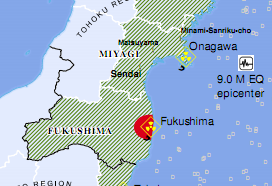After major natural disaster events like the earthquake and tsunami that rocked Japan last week, the UN Office for the Coordination of Humanitarian Affairs (OCHA) kicks into gear to coordinate the humanitarian aid communities response. One of their many tasks is to provide a steady stream of information about the disaster and response collected from several different sources.
Since the March 11 earthquake, OCHA has released three situation reports. The latest report was posted moments ago and reveals some grim facts and figures on the Japanese disaster.
Casualties:
1,647 confirmed dead. 1,990 injured. More than 10,000 still missing
Property damage:
Around the northern coastal region of Tohoku, the Government reported that 2,852 buildings were destroyed and over 40,000 damaged either by earthquakes, tsunami or fire. The tsunami waves caused the greatest destruction; and an estimated 5,000 houses remain inundated with water in Iwate. In Sendai city of Miyagi 2,700 houses have been washed away, and 1,800 houses destroyed in Fukushima. The number of houses destroyed is also expected to increase as Government assessment teams gain access.
Infrastructure Damage:
The National Police Agency’s latest assessment reports 827 roads, 47 bridges, and seven railways damaged. Transportation systems remain paralyzed. Communication is down for more than 20,000 people in Minami-Sanriku-cho and Matsuyama of Miyagai prefecture, as well as Otsuchi in Iwate Prefecture.
Nuclear Risk:
Authorities report that the reactor core is still intact. Today’s explosion was in Fukushima Daiichi’s reactor 3. There are also concerns for a third reactor at the plant which has lost its cooling system. The Government stated that 177,503 people living within a 20 km radius surrounding the Nuclear Power Plant No. 1 have been evacuated as a preventative measure and is urging calm. An additional 32,426 people living in the 10 km radius of Power Plant No.2 have been evacuated. There are 109 evacuation centres in Ibaraki Prefecture and 72 evacuation centres in Tochigi Prefecture, each with a capacity for 18,000 and 10,000 people, respectively.
The International Search and Rescue Response:
The Government of Japan has received offers for assistance from 91 countries, and has accepted assistance from about 15 countries based on assessed needs, which is mostly specialized international urban search and rescue (USAR) teams and medical teams.
Here is a list of those countries and the capacity that they have sent to Japan:

